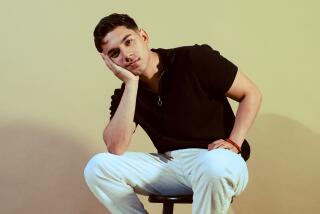Tango Expert Piazzolla in Step With Modern Times
Flash! Bandoneonist Astor Piazzolla has a new band. Itâs called the New Tango Sextet.
Hot news, right? Excuse me, while I step aside to avoid the loud chorus of yawns.
Who, you may ask, is Astor Piazzolla? What is a bandoneon, and why should you care? Ah, good questions.
Consider this: Piazzolla is universally acknowledged as perhaps the worldâs greatest tangoist. He is to the sensuous music of Argentina what Duke Ellington and Louis Armstrong were to jazz. In Piazzollaâs hands, the bandoneon (actually a button accordion) and the tango have become the starting points for compositions which transform a national dance music--a music which emerged from a blending of Cuban habanera, black candombe and Andalusian tango--into a rich and complex vehicle of contemporary expression.
Need more evidence? OK. Sting calls Piazzollaâs music: âGreat to make love to if you canât tango.â The Grateful Deadâs Mickey Hart says, âHis sound makes your hair stand on end.â And Pat Metheny says that Piazzolla is one of his âfavorite musicians of all time.â
Last year, the 67-year-old Piazzolla--whose Los Angeles debut takes place tonight at UCLAâs Royce Hall--made a few changes in his group. To tango aficionados, the modifications in an ensemble which had remained stable for 27 years were roughly equivalent to the startling departure of Johnny Hodges from the Ellington band in the early â50s.
Piazzollaâs explanation was typically direct and to-the-point. âI write for my musicians,â he said. âIâve done it that way all my life. And after having composed music for the same group for 27 years--hundreds of pieces of music and arrangements and sound--I found myself against a wall. I wanted to do something different. So I changed two players--the violinist and the pianist.
âInstead of a violin, I added a cello, for a more dramatic sound. And I added a pianist who is a very important contemporary composer in his own right. When I write for him, I have new world of music available to me, sounds and knowledge.
âFinally, I added another bandoneon. Back in the â30s, when tango groups were first trying to do something different with the music, they used to make tango solos for two bandoneons. I want to create a comeback of that style and put new harmonies and rhythms with it. Iâve found out how to do that, and Iâm having great fun with it.â
Born in Argentina, Piazzolla was brought to the United States when he was 2 years old, and grew up in the turbulent ethnic crosscurrents of New Yorkâs Little Italy. âI learned everything there,â he said. âI got good beatings, I gave good beatings, and I learned to defend myself. I learned to have courage, and not to be afraid. When you study music, you can be the greatest musician in the world, but if you donât have the courage to do what you want, to find your own individual style, then why did you bother to study music for so long?â
Piazzolla studied the bandoneon-- and there was no question that he did it with his own style. The instrument is the quintessential element in tango music, but Piazzollaâs New York years exposed him to Bach, Mozart, Gershwin, Ellington, and very little tango. When he returned to Buenos Aires in the late â30s he was a hybrid artist--studying with the likes of Alberto Ginastera and Nadia Boulanger, composing classical pieces and film scores, and creating modern-sounding tangos which both outraged and fascinated the musicâs purists.
Things havenât changed much. Today, Piazzolla is just as determined to chart his own path. âIâm doing what I want. I always do,â he said. âBut, look, Iâm not a Julio Iglesias. I play none of the old repertoire--âLa Cumparisita,â pieces like that. God forbid. There are some stupid people who expect me to play things like that to get more applause, but I wonât do it; Iâll never sell my soul to the devil for applause--never. Iâm not interested in being the richest man in the cemetery.
âIâm also not interested in what tango was. Iâm interested in what it will be in the future. When the water doesnât run, it rottens. And that happens with tango. Tango that doesnât run--it rottens. I donât like the smell of whatâs rotten. I have a great respect for the old tango, for the primitive tango. But I must do it in my own way.
âWhen Gil Evans did a modern arrangement, you could always hear that it was jazz. The same thing applies to the tango in my music. The accentuation, the feeling, is like jazz--like the blues. You canât explain what the feeling is, but you have it inside, because youâve learned it since you were a kid.
âIâve been listening to tango since I was a little boy, but itâs not as though each time I write a composition I say to myself, âLook, Astor, you have to put some tango in here.â I donât have to do that. Anything I write will have tango underneath it, always. I was raised in this music, I played it all my life, and I have it inside my veins.â
More to Read
The biggest entertainment stories
Get our big stories about Hollywood, film, television, music, arts, culture and more right in your inbox as soon as they publish.
You may occasionally receive promotional content from the Los Angeles Times.










